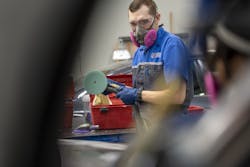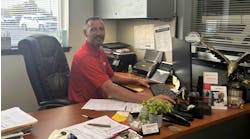Between 2022 and 2025, there will be a demand for more than 60,000 new collision repair technicians. In 2022 alone, that number is north of 18,000.
While that mirrors typical average growth for all occupations, according to the Bureau of Labor Statistics, there’s a problem. Unlike other industries that have a consistent pipeline of talent, there’s nobody to fill the body shops.
According to the TechForce Foundation’s 2021 Technician Supply and Demand Report, just over 4,500 students completed post secondary collision programs in 2020, a 12 decrease from 2019.
And while the technician shortage has been a point of worry for many years, the pandemic exacerbated it. Pre-COVID projections by TechForce suggested just over 15,000 new technicians would be needed in 2021. That jumped to 25,000 after COVID as the industry, just like every other, experienced “The Great Resignation.”
Behind battling insurers, a shortage of qualified technicians ranked as the biggest challenge facing shop operators, according to the 2021 FenderBender Industry Survey.
“It’s been a problem that nobody has addressed as it should be for years, and now it’s really out of control,” says Mary Mahoney, Enterprise’s vice president of the replacement and leisure division. “I feel for the shops because they need technicians now. They needed them last week, last year.”
The switch can’t be flipped overnight. There aren’t 18,000 technicians ready to enter shops tomorrow.
But what does the training landscape look like? In an effort to understand the progress being made and the current roadblocks still ahead, FenderBender spoke with stakeholders across the industry. From OEMs to technical schools to rental car companies and more, we sought to see what new programs are popping up and how established programs are planning to combat the industry’s most pressing need.
Addressing Industry Roadblocks
What are the roadblocks that the industry faces in recruiting students into the collision repair industry and trades in general?
While there are many small reasons to point to, all industry stakeholders believe the perception of collision repair within the school administrations plays a big role. From principals to teachers to counselors.
To Scott Kaboos, for too long the industry has gotten schools’ “D” students. But that’s not a viable option anymore.
“We don’t need your ‘D’ student. These cars are too complex. Our system has shoved everybody into one little box but not everybody fits in that box,” says Kaboos, Honda’s National Assistant Manager of its collision repair training division, adding that four-year colleges are not the only option for successful students.
Combating that way of thinking is a major point of concentration for the Collision Repair Education Foundation, especially with counselors. Counselors serve an influential role in students' post-high school decision making, and up until this point collision repair isn’t on their radar nationally, says Brandon Eckenrode, CREF’s executive director, adding most still see collision repair as dark and dingy. And if counselors do recommend the aftermarket, it's often for the mechanical industry, he says. CREF is hoping to change that.
In 2022, CREF will be a diamond sponsor at the American School Counselor Association's annual national conference in Austin, Texas. That will allow Eckenrode and his staff time to present to counselors from around the country.
“We hear from the association that they understand that they need to embrace technical education,” Eckenrode says. “They want more resources to help students learn about the industry.”
Eckenrode hopes that tangible interaction will be a launching pad to more recognition.
The need for a perception change also extends to the students. While counselors may not be pushing the industry, students aren’t naturally flocking to it either.
Programs like the Universal Technical Institute admit it has been tough to get students interested in the field. The school is currently in the midst of updating its training aids and marketing curriculum to fit the younger generation.
“We just need to evolve our approach,” says Anthony Pham, president of UTI’s Long Beach campus.
That means getting more involved on social media platforms like TikTok. It also means doing away with the word “mechanic” and replacing it with technician.
Enterprise is going a step further. Instead of saying technician, or collision repair, the company has rebranded the program as collision engineering. Mahoney sees the change as an accurate reflection of the job today. With the complexity of vehicles and the emphasis on technology, it has become a form of engineering. While the title changes seem small, it all adds up to further legitimize the career path like it hasn’t been before.
“We can build the best training in the world but if nobody knows then we are wasting our time,” Mahoney says.
That’s why part of Enterprise’s initiative includes funding for an aggressive marketing campaign.
“Everybody is talking about the problem but nobody is investing in trying to recruit,” she says.
The goal of the campaign, which markets the industry as “where Silicon Valley and Motor City collide,” is to “get butts in seats,” Mahoney says.
Specifically, Mahoney is keying in on groups females, veterans and career changers, which she feels are underrepresented parts of the industry.
“Part of the problem is people don’t understand this is a good career opportunity,” she says.
The Players
The OEMs
Kaboos is envious of Japan. As Honda’s National Assistant Manager of its collision repair training division, Kaboos had the opportunity to visit Honda’s headquarters in Japan, which includes two four-year, Honda-run universities. At the university, students spend the first two years learning all the mechanics of a car before spending the last two years in a specialization like collision repair and refinishing that puts students on track to become technicians the minute they graduate.
Kaboos sees it as an ideal model, but one that he doesn’t think will make its way to the U.S., at least anytime soon.
“It’d be wonderful if we could do that, I’m not just not sure,” he says. “This is such a different culture … the acceptance just isn’t there.”
If it’s ever going to happen, progress would need to be gradual. Kaboos has been leading the charge in Honda’s progress, establishing the manufacturer’s first brick-and-mortar hands-on training program in conjunction with a Chicago-area community college, which resumed its second round of classes in October after an extended hiatus due to COVID. Previously, Honda had done any and all training online. For now, Kaboos is focused on relaunching the program after the long break, but hopes the program can expand to more cities and community colleges soon.
“If you look at other manufacturers like Toyota or Audi, they have hands-on training. It just makes the program much more robust. That was the next step for us,” Kaboos.
BMW has also made additions to its collision repair program. While it’s had the STEP program since 1997, the program has been largely focused on the mechanical side. The training centers were 90/10 mechanical work. But in 2019, the program went through an expansion, which included the building of a collision-specific program in Spartanburg, S.C. In 2022, the program will be expanded to locations in Woodcliff N.J. and Ontario, Calif. These locations operate 90/10 in favor of collision repair, and will put technicians through a 36-week program.
BMW is also making efforts to speed up its training program. On the mechanical side, the company established the FastTrack program, which puts students at several Universal Technical Institute (UTI) locations through a 12-week program that gets them ready to work in a dealership or certified shop.
Gary Uyematsu, national technical training manager at BMW, says they hope to create the same for the collision repair industry.
“100 percent we’re looking at a FastTrack program for collision,” says Uyematsu, adding that the candidate pool will need to increase before that gets added.
BMW is also adding a program in 2022 that will allow shops to enroll their body and paint team in mechanical classes.
Technical schools
While OEMs providing training is helpful, they are most often training students who are already enrolled at a community college or technical school. Top among BMW’s partners is UTI, which is one of the largest feeder programs for collision repair techs.
According to TechForce Foundation’s 2021 Technician Supply and Demand Report, several of the top ten schools that graduated the most techs last year were UTI locations.
The UTI collision repair program is currently a 51-week program with three specialized training paths. The program is a product of several industry relationships with the likes of Axalta, 3M, Chief Collision and I-CAR.
Pham is the president of one of those UTI locations, located in Long Beach, Calif., and sees the program as a way to jumpstart a technician’s progression. There doesn’t need to be slow multi-year growth that sees the employees rise from washing cars to becoming a fully capable tech.
“Five or six years of slow growth can happen in a year here,” Pham says.
Pham also sees room for massive growth for his campus and the Houston campus, the other UTI location that is massively focused on collision repair. As a relative newcomer, having joined the organization in January 2021, Pham has spent the time looking to improve processes in the organization.
Already successful before Pham’s arrival, he has been careful not to change too much. With the collision repair program, Pham’s been keen on continuing to get the school’s name out there. The organization has hosted countless open houses, they’ve attended the Long Beach Grand Prix and gone into high school classes, all with the hope of getting more people into the training program.
Industry Stakeholders
While OEMs generally have the most funding and trade schools’ number one priority are programs like collision repair, other industry stakeholders are also contributing. One of those is Enterprise.
In January 2021, Enterprise, alongside Ranken, launched the Automotive Collision Engineering Pilot Program, a two-year program featured in three different community colleges nationwide.
The program follows the Ranken apprenticeship system, which sees students rotate between eight weeks of classroom/lab experience and eight weeks of full-day work-based learning at a participating collision repair facility. A portion of the student’s pay for work completed at the shop is also subsidized by the program. Several independent shops as well as the Ford Certified Collision Network are participating in the program.
“It’s the right thing to do to support the industry; to take a lead with a program everyone can participate in,” Mahoney says.
The program’s advisory board includes executives from American Family, Caliber, Chief, Ford, GEICO, Gerber, the Hermanek Group, I-CAR, Professional Parts Group, Progressive, Repairify, the Society of Collision Repair Specialists and Service King.
Enterprise also launched a new informational website in December that hopes to provide education to students interested in the career path.
Mahoney, who has worked for Enterprise for 36 years, is hoping to duplicate the program out to more cities once the current pilot has been tested. Enterprise received a $700,000 grant from the government to help fund the program and Mahoney says there are millions more in funding that other organizations should take advantage of to create similar programs.
So what can shops do?
While OEMs, trade schools and industry organizations have more resources — time, money and manpower — than individual body shops to invest in addressing the shortage, each industry stakeholder emphasized the massive role that body shops can play in their success.
To truly combat the technician shortage in a meaningful way, all parts of the industry need to work together.
“I think it’s a responsibility of every stakeholder in the industry to pay attention to what’s going to happen in the next generation or we’re not going to exist,” Kaboos says.
And body shops are on the ground floor.
Nearly every stakeholder FenderBender spoke with reiterated the importance of getting involved with local schools. Eckenrode recommends joining the local school district’s advisory board. Make an effort to meet the students. Talk to them in the classroom and invite them to the shop.
COVID-19 made every school look closely at its budget, Eckenrode says, and it’s no secret that body shop classes cost exponentially more than a math class. So it’s vital that administrators understand the importance of the classes. That doesn’t happen without local businesses having a presence.
Eckenrode also says image plays a large role in the younger generation’s understanding of the industry. The profession needs to look “visually attractive.” So if the local schools shop area looks run down, help it out.
“If administrators can see a line out the door of shops that are waiting for these students, you want to hope that they understand why they need to keep these programs around,” Eckenrode says.
At a national level, CREF is in the early stages of a fundraiser that will fund a PSA campaign about the industry for students, teachers and administrators. In partnership with BASF and KTL Restorations, CREF will be rebuilding a ‘69 Camaro to raffle off at SEMA 2023.
Other state associations have put together similar campaigns. The Alliance of Automotive Service Providers Minnesota has helped fund MNCARS, an organization that promotes the service and collision repair industry in the state. The organization’s efforts have contributed to more than 3,250 student enrollments in automotive programs.
The website includes powerpoint presentations to give to counselors and teachers, and letters in five different languages that gives parents an understanding of the industry, all of which can be freely accessed for shops to use.
If donating your time isn’t a realistic scenario, donating knowledge and equipment is equally valuable. Mahoney is looking to expand Enterprise’s program across the country, but the process of vetting potential schools is a time consuming process, so she needs help finding qualified schools. Kaboos recommends donating newer cars to high schools and community colleges as often those programs are forced to do restorations because they can’t do anything else.
“We can’t do this alone,” Mahoney says. “We need everybody to participate.”




